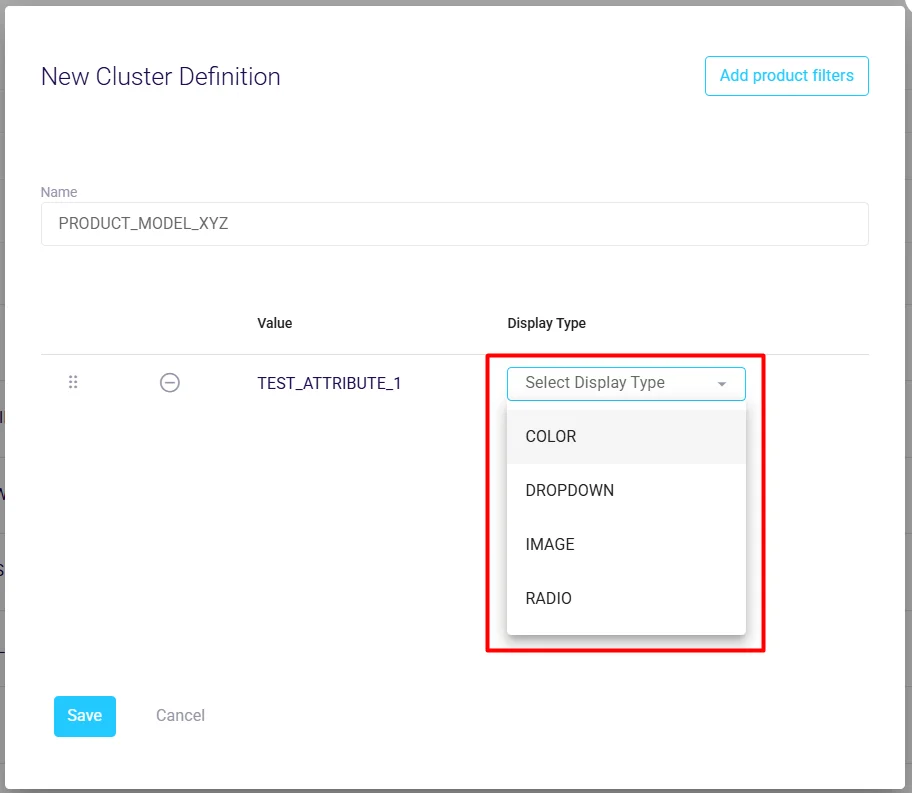Create cluster definitions
Goal
To create cluster definitions in Propeller that group products based on shared attributes, enabling structured drill-downs in the front end. Cluster definitions determine how product variants are organized and displayed to customers.
Step 1: Navigate to Cluster Definitions
- From the backoffice menu, select Admin and then Cluster Definitions.
- The cluster definitions list displays:
- Name
- Product filters count
- Created date
- Modified date
- Use the search bar to find existing definitions by name.
Step 2: Create a New Cluster Definition
- Click New Cluster Definition button in the top right corner.
- Enter a Name for the cluster definition (e.g.,
SHOES_MODEL_X).
- Use generic names as definitions can be reused across multiple clusters
- Follow naming conventions for consistency

Step 3: Add Product Filters
- Click Add Product Filter to select attributes for drill-down functionality.
- Choose from available product attributes in the system.
- Only existing product attributes can be added as filters
- Each filter represents a selection option for customers
- Select a Display Type for each filter:
- Color: Displays color swatches for visual selection
- Dropdown: Shows options in a dropdown menu
- Image: Uses product images as selection buttons
- Radio: Provides radio buttons for single selection

Step 4: Arrange Filter Order
- Use drag-and-drop to reorder product filters by clicking and holding the drag handle.
- The order determines the drill-down sequence in the front end:
- Higher priority filters appear first
- Consider logical selection flow (e.g., size before color)
- Review the final arrangement before saving.

Step 5: Save the Cluster Definition
- Click Save to create the cluster definition.
- A confirmation message will appear.
- The new definition is now available for use when creating clusters.
Editing Cluster Definitions
Product filters can be modified after creating a cluster definition:
- Click on an existing cluster definition to edit it.
- Add, remove, or reorder product filters as needed.
- Save your changes.
IMPORTANT: When editing cluster definitions that are already in use:
- Check all associated clusters to ensure they have valid entries for any new filters
- Adding new filters requires updating existing clusters with appropriate values
- Removing filters may affect front-end display of associated clusters
- Test changes thoroughly before applying to production clusters
Best Practices
- Prerequisites: Ensure all required product attributes exist before creating definitions
- Naming Convention: Use clear, uppercase names with underscores (e.g.,
PRODUCT_TYPE_VARIANT) - Logical Organization: Arrange filters in order of customer decision-making
- Display Type Selection:
- Use Color for color attributes
- Use Image for visual products like patterns or styles
- Use Dropdown for long lists of options
- Use Radio for limited options (2-5 choices)
- Testing: Create a test cluster using the definition to verify drill-down behavior
- Reusability: Design definitions to work across similar product types
Common Use Cases
Fashion Products
- Filters: Size, Color, Material
- Display: Radio for size, Color swatches, Dropdown for material
Electronics
- Filters: Storage, Color, Model
- Display: Radio for storage, Color swatches, Dropdown for model
Furniture
- Filters: Dimensions, Material, Color
- Display: Dropdown for dimensions, Radio for material, Color swatches
Important Notes
- Changes to cluster definitions affect all clusters using that definition
- Product filters must match actual product attributes for proper functionality
- Consider mobile experience when choosing display types
- Maximum recommended filters per definition: 4-5 for optimal user experience